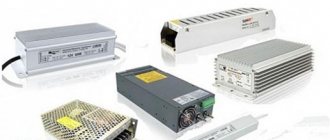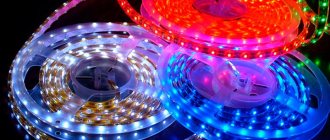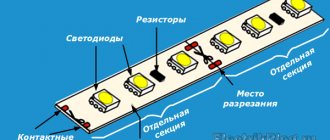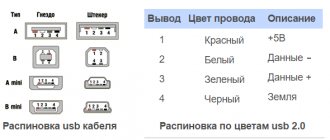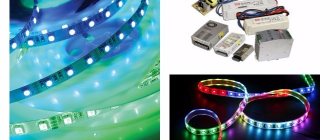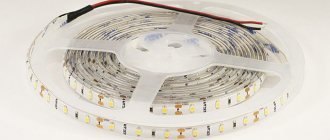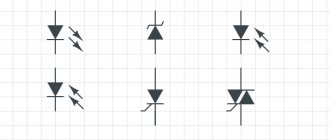Purpose of drivers for LEDs
The brightness of an LED lamp depends on 2 parameters: the current passing through it and the identity of the characteristics of the semiconductors, since any discrepancy will damage the parts. But modern production is not able to provide completely identical crystal parameters.
The instability of the current in a 220-volt network and the difference in characteristics leads to degradation of the material and combustion of the LED. To avoid this, install a driver.
It converts electric current:
- sets its amplitude;
- straightens - makes it permanent;
- supplies the same current to all elements (slightly less than the maximum level) and prevents their breakdown.
Key Features
The main difference between the driver is that at the input voltage for which it is designed (for example, 140-240 V), it sets the specified current level on the LEDs. In this case, the potential at the output of the device can be any.
It has 3 main characteristics:
- Rated current. It should not exceed the rated value of the LED, otherwise the diodes will burn out or glow dimly.
- Output voltage. Depends on the type of connection of semiconductors and their number. It is equal to the product of the potential drop of 1 element by their number and can vary within wide limits.
- Power. The entire operation of the device depends on the correct calculation of this characteristic. To do this, sum up the powers of all elements and add 20-25% (overload reserve).
For an LED lamp with 10 elements of 0.5 W each, this parameter will be equal to 5W. Taking into account overload, you should choose a 6-7 W driver.
But the last 2 parameters (power consumption and output voltage) directly depend on the emission spectrum of the LED. For example, XP-E elements (red) at 1.9-2.5 V consume 0.75 W, and green ones consume 1.25 W with a power supply of 3.3-3.9 V. It turns out that the driver is 10 W capable of powering 7 diodes of one color or 12 of another.
Power theory for LED lamps from 220 V
An ice lamp, ceiling strip or backlight on a modern TV is a combination of several powerful small LEDs placed in the space in the right way.
To replace a 60 W light bulb (in terms of brightness), you will need about a dozen inexpensive semiconductor devices.
If each of them is capable of passing a current of 1 A at a voltage of 3.3 V, then they cannot be included in the lighting network - they will immediately burn out. You can use a resistor divider, but they will dissipate a lot of power. Therefore, the efficiency of the lamp will be small.
Drivers are used to reduce voltage and convert current into direct current. Inside these devices there may be various current stabilizers, capacitive-resistive dividers, etc.
The circuit may include transistors, microcircuits, capacitors, etc. Such converters change the voltage and provide the required amount of current to each element.
What kind of block is needed for LED strip?
We have already discussed the main parameters of power supplies for LED strips above: supply voltage and power. It remains to consider other features and characteristics that are taken into account when choosing them.
In addition to voltage and power, power supplies for LED strips also differ in the type of design (case), degree of protection from external influences and functionality. Each of these options provides some advantages or limitations for use in different environments.
Three main types of power supplies for LED strips:
1. In a plastic case. 2. In a metal case with perforation. 3. Sealed in aluminum housing.
The power supply for LED strips in a plastic case can be similar to the power supply from a laptop or the power supply from various devices, for example, a battery charger for a powerful router and others. As a rule, low-power power supplies have a plastic case and can only be used indoors. They have passive cooling through the body, so they cannot withstand strong overloads.
The power supply for LED strip in a metal case with perforation usually has more than average power and corresponding dimensions. The radio components in them are cooled by air circulating in the case, and in powerful models a fan can be installed for forced airflow, which can be accompanied by a lot of noise. The advantage of such power supplies is the presence of a large number of pins, mainly for fairly powerful models, and a voltage level regulator, i.e. If necessary, they can be slightly adjusted. They are installed mainly in shields, where they will be protected from dust.
Sealed power supplies for LED strips in an aluminum case are well protected from dust and moisture. They are cooled passively through the case; for connection to the 220V network and to the LED strip there are wire sections. They can be installed both indoors and outdoors.
IP rating of LED power supplies
The protection class of a power supply affects the conditions in which it can be used. The most common power supplies for LED strips in a plastic case or in a metal case with perforation have a protection class of IP20 or IP40. This means that they can be used in dry rooms with a moderate amount of dust; it is better to hide perforated ones in switchboards, otherwise over time they will become completely clogged with dust.
Power supplies for LED strips in aluminum sealed cases have a protection class of at least IP65, and they can already be used in bathrooms and on the streets under a canopy. For outdoor use, more protection is required and the housing must be IP67 rated. There are even more protected power supplies with IP68 and even IP69. They can already withstand direct exposure to jets of water and even complete immersion in water up to 1 m.
Types of power supplies for LED strips by functionality
1. The most common ones, performing only the function of powering the LED strip. 2. Power supplies with a built-in dimmer for brightness adjustment. 3. Power supplies for LED strips with remote control. 4. The most expensive combined power supplies with a control panel and a dimmer.
The functionality of the power supply allows you to save space and increase ease of use, so as not to have many different devices in one place. In the most expensive option, instead of three devices, you can install only one power supply for the LED strip, in which everything is already included. At the same time, the simplest power supplies without bells and whistles can boast of their small size.
Types of LED Drivers
There are several types of converters for semiconductor light sources. The main types are linear and pulse. Each of them is created for its own purposes and has its own nuances.
Linear
This type is used often. Its assembly, if all the parts are present, can last 5-10 minutes. It requires almost no adjustment - it starts working right away.
The circuit contains a linear current stabilizer, which can be thought of as a variable resistor controlled by an electronic circuit.
When input voltage is applied, it goes to the regulating element and then to the current control circuit (CT). After this, it appears at the output to which the load is connected. The CT unit checks the current and, depending on this, changes the resistance of the control element.
The disadvantage of such a device is low efficiency.
Pulse
This type of driver is based on a different principle. The regulating element here is the keys with a transformer. When voltage is applied, energy begins to accumulate on the windings (in a magnetic field). The current gradually increases.
As soon as it reaches the desired value, the keys will switch. The stored energy will go into the circuit, and the current will begin to decrease. When the minimum value is reached, the keys will work again and the process will repeat.
How to choose
To select an LED driver, it is necessary to comprehensively consider the characteristics of the device:
- input and output voltage;
- output current;
- power;
- level of protection from harmful influences.
First, determine the power source. A standard AC voltage network, battery, power supply and much more are used. The main thing is that the input voltage is within the range specified in the device passport. The current must also be suitable for the input network and the connected load.
Figure 5. Types of blocks
Manufacturers produce devices with or without housings. The housings effectively protect against moisture, dust and negative environmental influences. However, to integrate the device directly into the lamp, the housing is not a necessary component.
How the device works
The main job of the driver is to create a given current value at the output and maintain it. Any scheme of this type consists of several parts:
- network filter that protects the network from interference;
- capacitor-resistor (RC) or transformer unit to reduce voltage;
- diode bridge for rectification;
- current stabilizer.
A device with an RC filter works like this:
- A capacitor in an alternating current network performs the functions of capacitance. Together with the bridge, it forms a voltage divider and reduces it to the desired limit. The resistor in its circuit serves for self-charging.
- The reduced voltage is supplied to the current stabilizer, and from it to the LEDs.
A transformer unit is a device of a key or other type, controlled by a generator. It can be made on specialized microcircuits, high-voltage key transistors, simple elements or on a PWM controller.
This driver works as follows:
- when power is supplied, the bridge straightens it, and it goes to the switches, on which antiphase voltages are created with the help of windings;
- simultaneously with them, the generator is turned on, which generates pulses and starts the driver;
- the keys, turning on alternately, ensure uninterrupted operation of the device through the feedback circuit;
- an alternating voltage appears on the output winding, rectified by a bridge or 1-2 diodes together with electrolytic capacitors;
- Next in the circuit there is a current stabilizer, to which the LEDs are connected.
Calculation of the power of the supply transformer for 12 and 24 volts
Often, LEDs require a constant voltage of 12 or 24 volts, so we need to calculate the power of the device that will convert alternating voltage (220 V mains) to direct (12/24 V).
We will look at calculating power using the example of a simple SMD 3528 60 4.8 W/meter. Let's say its length is 16 meters.
Since manufacturers indicate the voltage on the packaging or on the tape itself, the power supply device must provide exactly this voltage for operation.
- On our tape, the operating voltage is 12 volts, so we must purchase a transformer with exactly this voltage with a certain degree of power.
- In order to make the correct calculation, we need to know the power consumption of the diodes 4.8 W/meter.
- We need to multiply 16 meters by the power of 4.8 W (16x4.8 = 76.8 W).
- Since the device must necessarily have 20 or 30% power reserve, to calculate the required power we need to multiply the result by 1.2. (76.8x1.2=92.16 W).
- But since 96 W power supplies are not sold, we will have to purchase a 100 W transformer.
If we are going to install the LED strip outdoors or in a room with a high level of humidity, then it is best to purchase a moisture-proof device with a sealed housing type IP65, 66 or 67.
Characteristics and differences from LED strip power supplies
Instead of a converter, you cannot use a simple power supply designed for the same voltage and current. Although both devices (driver and LED strip unit) perform almost the same function, there are significant differences.
A simple power supply converts voltage and produces direct current. The tape elements connected to it consist of an LED and resistors. There can be many such nodes in a tape.
It is difficult to control the glow of a semiconductor, since it depends on changes in the current value, and it is constant in a given node. To increase or change the brightness in an LED strip, you will have to simultaneously adjust all the resistors, and this is unrealistic.
The driver is a current stabilizer. The LEDs are connected to it in series. Since a regulating element can be inserted into any stabilizer, the brightness of the semiconductors can be freely changed. To do this, you just need to raise or lower the total current value.
Power
The first thing you need to decide is how powerful the power source should be. There are units from 20 to 400 W. To select the correct characteristics, you must first determine the power of the LED strip, and then add another 20% margin to this value.
You can find out the LED consumption from the table:
Unfortunately, it does not indicate how much 5630 LEDs, which are also quite often used by the population, consume. Typically, a 5630 LED strip consumes about 18 watts per meter (60 LEDs per meter).
For example, let's look at how to choose the power of the power supply for a lighting source with 5050 LEDs (60 pieces per meter). According to the table, this model consumes 15 W/m. For a 5-meter segment, the power will be 75 W (15 * 5) and + 20%, we get 90 W. It is better to choose a 100 W power supply, which will be quite enough to power the backlight.
Making a driver for LEDs with your own hands
If the user has several semiconductor crystals or a backlight line from an old TV, he can independently make a current source for them.
To do this, you should purchase devices and parts or remove radio elements from old equipment. Often the efficiency of self-made devices is much higher than that of industrial designs.
Materials and tools for work
For a homemade simple driver you will need:
- capacitors: simple 0.27 uF at 400 V and 2 electrolytic 500×16 V and 100×16 V;
- resistor 500 kOhm at 0.5 W;
- 4 diodes or a ready-made bridge for 220 V;
- LM317 chip;
- soldering iron with a power of 20-40 W;
- flux and solder (preferably POS type);
- pliers, wire cutters, pliers;.
- multi-core insulated copper conductors with a cross section of 0.35-1 mm²;
- heat shrink tube;
- multimeter or tester;
- insulating tape;
- board for desoldering elements.
Simple driver circuits for a 1 W LED and a powerful one
A classic converter is a combination of an electronic voltage divider and a stabilizer chip. The first node consists of 2 elements (a 0.27 μF capacitor and a 500 kOhm resistor) connected in parallel, to which a bridge of diodes that can withstand the input voltage is connected in series.
To smooth out pulsations, install 2 “electrolytes”. The first of them 500×16 V is soldered immediately after the bridge. Then a current stabilizer is installed. Behind it is a second capacitor 100×16 V.
The L7812 chip is often used as a stabilizer, but this is not entirely the right solution. It is a linear voltage regulating device and can burn out if the current changes.
Connection diagram
It is better to use LM317, LM338 or LM350 microcircuits, which have protection against short circuits and overheating. They can be powered with any voltage 5-35 V. 5-10 LEDs can be connected to the driver.
The connection diagram is simple:
- the plus of the divider goes to the input of the microcircuit (1 output);
- the common wire through the anode of the LED goes to the minus of the radio component (middle leg);
- The LM317 output (pin 3) is also connected there through a current-limiting resistor.
By installing an adjustable resistance instead of the last element, you can change the current strength, i.e., the brightness of the LEDs within certain limits.
If you need to build a powerful spotlight, then the driver will have to be modified:
- it is necessary to increase the supply voltage to 24 V;
- install a stabilizer with the highest current, and of the proposed microcircuits, only LM338 can output 5A.
Due to the high current, it should be installed on a radiator.
How to assemble and configure the driver?
A simple LED converter has few elements. The driver can be assembled on a special board, a piece of plywood, or mounted.
The device does not require adjustment if you take all the specified parts. The main thing is to correctly calculate the current limiting resistor.
Calculation for a transformer
In order for the device to work correctly and not create problems later, you need to calculate the power of the purchased transformer before you begin installing the LED strip ceiling lighting. This is not difficult to do.
As an example, you can consider a product labeled 3528 and a placement density of 60 pieces per meter. The amount of energy consumed is 4.78 watts per meter. The power of the converter must be no less than what the chips consume.
If the total length of the segment is, for example, 5 meters, then together they will consume 24 watts of energy. This means that the converter must produce at least 24 watts. But these are not the only parameters that need to be taken into account. A 20% energy reserve is required. This means that we need a converter that will provide 24+20% of energy. The final value is 28.8 W, so it must be more powerful than this figure.
You have to choose a converter that will best meet the specified requirements for output watts of energy and voltage.
Nuances of a driver without a current stabilizer
Many users do not install a microcircuit or other similar component at all. But the absence of a transformer leads to voltage and current ripple.
The brightness of the LEDs also changes. The problem is partially solved by a capacitor installed after the bridge. If the stabilizer is not installed, then the minimum ripple value will be 2-5 V.
The option with a microcircuit will get rid of the problem. Therefore, a driver installed by yourself will not be inferior to foreign analogues in terms of pulsation.
Rules for calculating technical parameters
The performance of any device depends on correctly selected components. Therefore, it is necessary to know how to calculate each element of the driver.
The capacity of the quenching capacitor is determined by the formula:
C(uF) = 3200*I load/√(Uinput²-Uoutput²)
For example, for LEDs with a current of 300 mA:
C(μF) = 3200* 300 /√(220²-24²) = 4.367 μF.
The value of the limiting resistance is directly proportional to the amount of current consumed:
- 500 mA – 2.5 Ohm;
- 250 mA – 5 Ohm;
- 125 mA – 10 Ohm.
Knowing these values, you can calculate the resistor for any number of LEDs.
